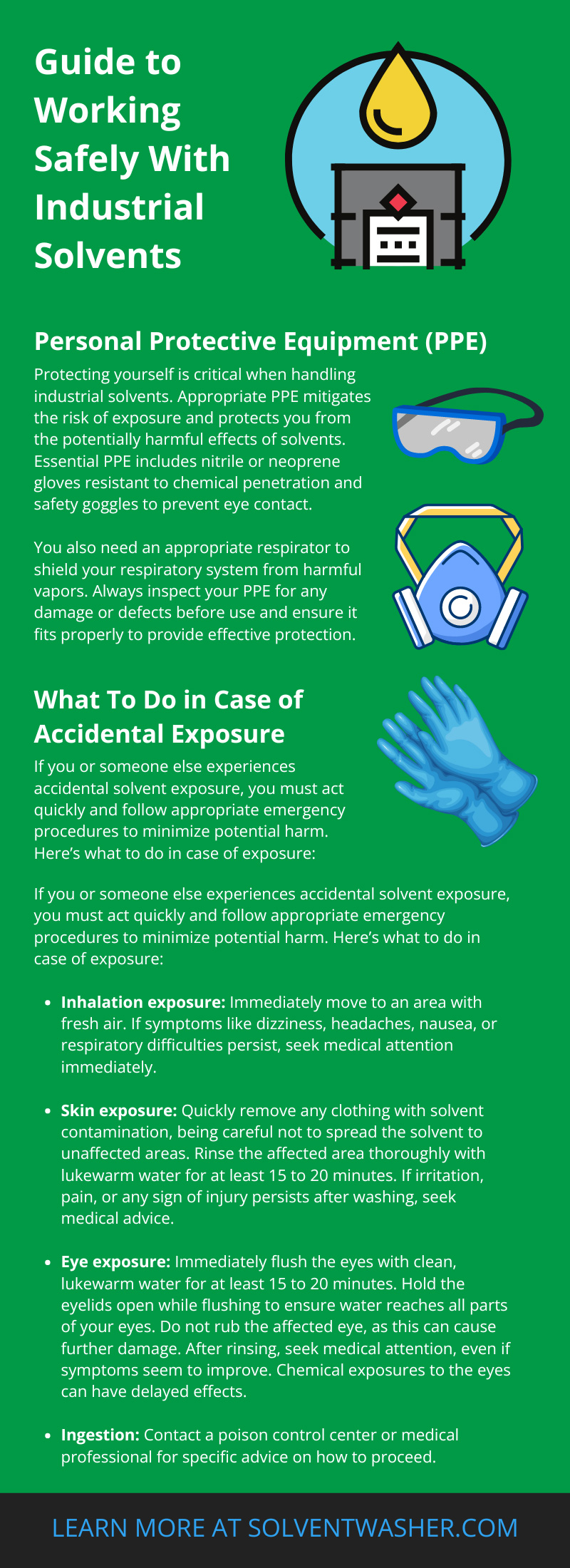Industrial solvents are common in various industries for cleaning, degreasing, and other applications. However, they become significant health and safety risks if you don’t handle them correctly. Fortunately, our guide to working safely with industrial solvents offers the best advice on mitigating risks and ensuring a safe workspace for everyone.
Personal Protective Equipment (PPE)
Protecting yourself is critical when handling industrial solvents. Appropriate PPE mitigates the risk of exposure and protects you from the potentially harmful effects of solvents. Essential PPE includes nitrile or neoprene gloves resistant to chemical penetration and safety goggles to prevent eye contact.
You also need an appropriate respirator to shield your respiratory system from harmful vapors. Always inspect your PPE for any damage or defects before use and ensure it fits properly to provide effective protection.
What To Do in Case of Accidental Exposure
If you or someone else experiences accidental solvent exposure, you must act quickly and follow appropriate emergency procedures to minimize potential harm. Here’s what to do in case of exposure:
- Inhalation exposure: Immediately move to an area with fresh air. If symptoms like dizziness, headaches, nausea, or respiratory difficulties persist, seek medical attention immediately.
- Skin exposure: Quickly remove any clothing with solvent contamination, being careful not to spread the solvent to unaffected areas.Rinse the affected area thoroughly with lukewarm water for at least 15 to 20 minutes. If irritation, pain, or any sign of injury persists after washing, seek medical advice.
- Eye exposure: Immediately flush the eyes with clean, lukewarm water for at least 15 to 20 minutes. Hold the eyelids open while flushing to ensure water reaches all parts of your eyes. Do not rub the affected eye, as this can cause further damage. After rinsing, seek medical attention, even if symptoms seem to improve. Chemical exposures to the eyes can have delayed effects.
- Ingestion: Contact a poison control center or medical professional for specific advice on how to proceed.
Other General Steps
- Inform others: Notify a supervisor, safety officer, or emergency response team immediately about the incident.
- Use safety data sheets (SDS): Refer to the SDS for the specific solvent for additional first aid measures and instructions.
- Document occurrences: Document the exposure incident, including the circumstances, the type and amount of solvent involved, and the first aid measures you took.
Ventilation and Exhaust Systems
A well-ventilated workspace is crucial to disperse solvent vapors and reduce inhalation risks. Use local exhaust ventilation systems near the source of vapor generation to capture contaminants and expel them from the work area.
Regularly check and maintain these systems to ensure they function efficiently. If you’re unsure about the ventilation requirements for specific solvents, consult the safety data sheets (SDS).
Signs of Inadequate Ventilation
If you suspect problems, you must recognize the signs that indicate inadequate ventilation. First, persistent chemical odors are clear signs of trouble. Proper systems should remove solvent vapors and odors from the air, so their continuous presence indicates that the system isn’t functioning efficiently.
Furthermore, difficulty breathing, throat irritation, coughing, or other respiratory symptoms can indicate insufficient removal of solvent vapors from the work environment.
Visible fumes or dust in the air also signal that the system isn’t capturing and removing contaminants.
Proper Storage of Solvents
Storing solvents safely helps prevent accidents like fires, spills, or leaks. Store all solvents in containers approved for chemical storage, with visible labels indicating the contents and associated hazards. For instance, flammable solvents go in fire-resistant safety cabinets because they have double-walled steel with air space in between. The material helps insulate the contents from external heat sources.
Regardless of the solvents, keep these containers in a cool, dry area away from direct sunlight, heat sources, and any ignition points (including flames and sparks). A routine check of storage areas is necessary to look for signs of container damage or leaks.
Understanding Flash Point and Boiling Point
Knowing the physical properties, especially the flash point and boiling point of the solvents you handle, is key to preventing fire and burn hazards. The flash point is the lowest temperature at which a solvent emits enough vapor to ignite, while the boiling point is the temperature at which the liquid turns into a vapor.
This information dictates the types of environments to use chemicals in and informs the necessary safety precautions to take. For example, if a solvent has a flash point below room temperature, that means it can emit ignitable vapors at all times. Thus, using explosion-proof equipment and conducting operations in well-ventilated areas are critical safety measures.
Minimizing Contact and Inhalation
Direct contact with solvents can lead to skin irritation, chemical burns, or systemic health issues. Moreover, inhaling high concentrations of solvent vapor can have serious respiratory effects. Specifically, exposure to acetone and methanol can lead to everything from mild respiratory irritation to severe lung damage, depending on the level and duration of exposure.
To minimize these risks, use tools like pipettes, fume hoods, or automatic dispensing systems that limit direct handling of solvents. Incorporating these practices reduces the likelihood of spills and accidents while lowering the potential for direct exposure.
Avoiding Eating, Drinking, or Smoking
Keep your eating, drinking, and smoking areas separate from solvent locations. This prevents accidental solvent ingestion, which can lead to health complications. Implement a policy that requires everyone to wash their hands thoroughly after using solvents and before going on breaks or finishing shifts. Furthermore, never wear contaminated clothing in designated eating areas.
Spill Response and Cleanup
Handle spills quickly and efficiently by utilizing appropriate spill kits that neutralize and absorb chemical substances. Make sure to familiarize yourself with the location of these kits and ensure you understand how to use them properly. Dispose of contaminated materials, such as rags or PPE, according to your facility’s hazardous waste disposal procedures to prevent environmental harm or fire risks from solvent-soaked materials.
Manufacturer’s Instructions and Safety Data Sheets
Following the manufacturer’s instructions and the SDS is crucial for safety. These documents contain detailed information about the solvent’s properties, hazards, safe storage, handling procedures, and first-aid measures. They also include emergency contact information in case of exposure. Ensure that you read and understand these documents for each solvent you work with, and consult them in case of any doubt about handling procedures.
Solvent Recycling
In addition to following safety protocols, solvent recycling is a sustainable practice that reduces waste and lowers the costs of chemical use. Solvent recovery equipment allows you to reuse many industrial chemicals. By decreasing the need for new solvents, workplaces can reduce harmful chemical exposure and minimize their environmental footprint.
Final Thoughts
Working safely with industrial solvents requires a proactive and informed approach. By following the guide to working safely with industrial solvents, you help create a safer workplace while protecting your environment. Always be vigilant and report any unsafe conditions or practices to your safety supervisor.


